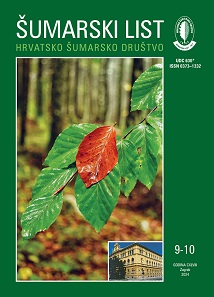Phenotypic variation in leaf in matural populations of Quercus petraea ((Matt.) Liebl.) in Bosnia and Herzegovina
Keywords:
Quercus petraea, populacija, varijacija, listovi, morfološka svojstvaAbstract
Sessile oak (Quercus petraea (Matt.) Lieblein) is one of the economically and ecologically very important species of forest trees, which occurs in about 15% of all forests in Bosnia and Herzegovina. The natural populations of sessile oak in Bosnia and Herzegovina represent specific communities that differ from individuals from their optimum in Western, Southern, and Eastern Europe and are essential for the preservation of sessile oak biodiversity in Europe. The goal of the research is to determine the degree of intra-population and inter-population variability of the oak in Bosnia and Herzegovina by analyzing the morphological traits of leaves, as well as the relationship between the variation of populations in phenotypic properties and geo-climatic factors. The results will be used when choosing conservation measures for this forest tree species.
Thirteen traits of leaves (shown in Figure 2) were analyzed on 237 trees from 24 natural populations (Table 1, Figure 1) of sessile oak.
The results showed that the coefficients of variation for all measured traits ranged from 13.3% for the leaf blade length to 26.5% for the leaf petiole length (Table 3). Analysis of variance (Table 4) revealed the existence of phenotypic variation within and among populations. Variation within populations was on average 28.44% and higher than among populations (average 16.2%). Cluster analysis showed the separation of populations into two main clusters, where Jajce-Komotin and Fojnica populations belonged to one cluster, and all other populations to the other cluster (Figure 7). Most of the leaf traits analyzed (except petiole length, leaf width-to-length ratio, and the number of lobes) were correlated with latitude, the mean temperature of the quarter with the most precipitation, and the amount of precipitation in the warmest quarter (Table 7).
The obtained variability of traits should be preserved because sessile oak populations will strive for a balanced state in the future, with corrections of the genetic structure through natural selection and migration.
Downloads
Published
Issue
Section
License
Copyright (c) 2024 Mirzeta Memišević Hodžić, Azra Čabaravdić, Dalibor Ballian

This work is licensed under a Creative Commons Attribution-NonCommercial 4.0 International License.


